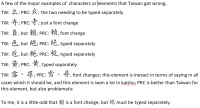feng
榜眼
I wanted to put this in the Current Products section, but you have to pick Apple or Android, and I am guessing the problem exists in both (though I am using an iPad, so tell me if I am wrong).
Pleco in regular (aka traditional) characters does not adhere to either Taiwan or the PRC's standards (or even make up its own reasoned standard). It is a random mix. I do not mean 為/爲, where both are listed when set for regular characters. I mean characters like 骨 and 過 which Pleco does the PRC way even as a regular character for the latter (both of which are nearly only seen that way in post-1949 PRC), whereas 爭 and certain others are done the Taiwan way (which the PRC opted out of even when traditional characters are used). There are further issues with Taiwan and PRC forms having separate entries, but also some things where example sentences use different forms than the entry uses, or a Taiwan form used for the head character when regular characters are turned off.
This is a highly abbreviated comment and question since I am not here to proofread Pleco, but I am wondering why things would be this way since Pleco has been around for some years now (15?), and the standard forms for both countries well predate Pleco as a company. I have been experimenting with the free version of Pleco as I am a Casio and 萌典 user (two different flavors, but each true to their original recipe, so to speak).
Simple questions: Why? Will this be fixed?
Pleco in regular (aka traditional) characters does not adhere to either Taiwan or the PRC's standards (or even make up its own reasoned standard). It is a random mix. I do not mean 為/爲, where both are listed when set for regular characters. I mean characters like 骨 and 過 which Pleco does the PRC way even as a regular character for the latter (both of which are nearly only seen that way in post-1949 PRC), whereas 爭 and certain others are done the Taiwan way (which the PRC opted out of even when traditional characters are used). There are further issues with Taiwan and PRC forms having separate entries, but also some things where example sentences use different forms than the entry uses, or a Taiwan form used for the head character when regular characters are turned off.
This is a highly abbreviated comment and question since I am not here to proofread Pleco, but I am wondering why things would be this way since Pleco has been around for some years now (15?), and the standard forms for both countries well predate Pleco as a company. I have been experimenting with the free version of Pleco as I am a Casio and 萌典 user (two different flavors, but each true to their original recipe, so to speak).
Simple questions: Why? Will this be fixed?

